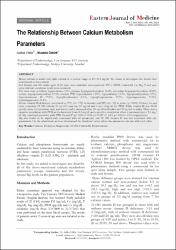| dc.contributor.author | Yıldız, Saliha | |
| dc.contributor.author | Öztürk, Mustafa | |
| dc.date.accessioned | 2019-12-26T17:11:57Z | |
| dc.date.available | 2019-12-26T17:11:57Z | |
| dc.date.issued | 2019 | en_US |
| dc.identifier.citation | Yıldız, S. ve Öztürk, M. (2019). The relationship between calcium metabolism parameters. Eastern Journal of Medicine, 24(4), 490-496. http://doi.org/10.5505/ejm.2019.46873 | en_US |
| dc.identifier.issn | 1301-0883 | |
| dc.identifier.uri | http://doi.org/10.5505/ejm.2019.46873 | |
| dc.identifier.uri | https://hdl.handle.net/20.500.12511/4739 | |
| dc.description.abstract | Blood calcium is under very tight control in a narrow range of 8.5-10.5 mg/dl. We aimed to investigate the factors that contributed to this control. 464 females and 254 males aged 16-96 years were examined retrospectively. PTH, 25OH vitamin D, Ca, Mg, P and spot urine calcium, creatinine levels were examined. The rates were as follow; hypercalcemia 5.6%, primary hyperparathyroidism 10.4%, secondary hyperparathyroidism 40.8%, tertiary hyperparathyroidism 17.5%, normal PTH hypercalcemia 1.25%, hypocalcemia 13.5%, hypoparathyroidism 3.7%, hypovitaminosis D 77.6%, hypophosphatemia 6.4%, hyperphosphatemia 17.5%, hypomagnesemia 17.5%, hypermagnesemia 10.4%. Severe vitamin D deficiency was found as 37% (n= 172) in females and 20% (n= 53) in males (p <0.01). Urinary Ca and urine creatinine 25 OH vitamin D cut-off value was 10 ng/ml and it was 13ng/ml for PTH. While vitamin D was 10-20 ng/ml, urine Ca/creatinine ratio was lowest and it increased after 20 ng/ml in females and 30 ng/ml in males. There was a negative correlation with PTH as Ca decreased from 8.3 mg/dl and a positive correlation when it increased above 9.2 mg/ dl. Mg correlated positively with PTH, Ca and P (p= 0.00 r= 0.23, p= 0.007 r= 0.13, p= 0.00 r= 0.21, respectively). Mg was found to be significantly correlated with all parameters and 25 OH vitamin D was not correlated with any parameters. On the other hand, we have determined the threshold values where the parameters interact with each other. | en_US |
| dc.language.iso | eng | en_US |
| dc.publisher | Yüzüncü Yıl Üniversitesi Tıp Fakültesi | en_US |
| dc.rights | info:eu-repo/semantics/openAccess | en_US |
| dc.subject | Calcium | en_US |
| dc.subject | Poshphor | en_US |
| dc.subject | Magnesium | en_US |
| dc.subject | 25 OH Vitamin D | en_US |
| dc.subject | Parathormone | en_US |
| dc.title | The relationship between calcium metabolism parameters | en_US |
| dc.type | article | en_US |
| dc.relation.ispartof | Eastern Journal of Medicine | en_US |
| dc.department | İstanbul Medipol Üniversitesi, Tıp Fakültesi, Dahili Tıp Bilimleri Bölümü, İç Hastalıkları Ana Bilim Dalı | en_US |
| dc.authorid | 0000-0002-0947-9498 | en_US |
| dc.identifier.volume | 24 | en_US |
| dc.identifier.issue | 4 | en_US |
| dc.identifier.startpage | 490 | en_US |
| dc.identifier.endpage | 496 | en_US |
| dc.relation.publicationcategory | Makale - Uluslararası Hakemli Dergi - Kurum Öğretim Elemanı | en_US |
| dc.identifier.doi | 10.5505/ejm.2019.46873 | en_US |
| dc.identifier.scopusquality | Q4 | en_US |


















